What Type Of Animal Is The Bearded Dragon
Bearded dragons are among the most common pet reptiles. People love them because they're simple to care for and delightful to interact with.
Standard or "wild-type" bearded dragons are beautiful in their own correct, just accept you ever heard of fancy bearded dragons ?
Fancy bearded dragons are selectively bred to await beautiful and unique. Fancy bearded dragons might be red, orangish, or even blue. They can have HUGE bodies, tiny scales, or zig-zag markings.
Now, you may be wondering:
- Where can I purchase a fancy bearded dragon?
- Where do fancy bearded dragons come up from?
- Exercise fancy bearded dragons nonetheless make great pets?
- What kind of fancy bearded dragon should I get?
We're here to answer all of those questions and more than!
In-Short
- Fancy bearded dragons are the same species equally normal disguised dragons.
- Fancy bearded dragons are selectively bred for unique appearances.
- They tin can be of unlike colors and sizes or have crazy patterns and scales.
- Fancy disguised dragons have most of the aforementioned husbandry requirements as normal bearded dragons.
- Fancy bearded dragons tin can cost a lot of money!
Taking on any pet is a big commitment. Luckily, caring for a fancy bearded dragon is relatively straightforward. In one case yous understand their needs for heating, lighting, and a healthy diet, it'due south like second nature. Don't worry, our disguised dragon care sheet will tell you EVERYTHING you need to know.
What Is a Fancy Bearded Dragon?
A fancy bearded dragon is whatsoever bearded dragon that was selectively bred to appear different from normal, wild-blazon bearded dragons.
Fancy bearded dragons are similar to purebred dogs and cats. Breeders ordinarily put a lot of attempt into cultivating their appearance and tracking their lineage.
Fancy bearded dragons may take traits that are refined over multiple generations. Alternatively, they may carry genetic morphs that appeared suddenly and unexpectedly in a clutch or wild-caught disguised dragon. Fancy bearded dragons can fifty-fifty have a combination of traits and morphs!
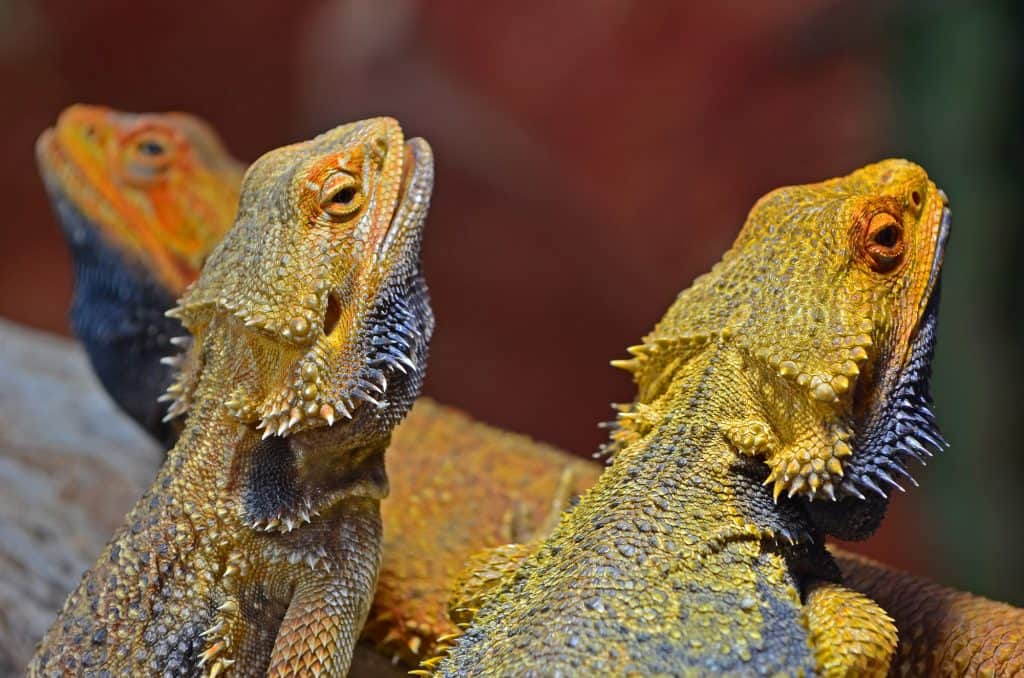
Some fancy disguised dragons are selectively bred for specific traits such as vivid colors, large size, or stripes. Some examples of selectively-bred fancy bearded dragon traits include:
- Tiger – fancy bearded dragons with continued stripes.
- Red – fancy bearded dragons selectively bred for their bright, fiery crimson color.
- Citrus – fancy bearded dragons that go more vibrantly xanthous every bit they age.
- Orange – a common fancy disguised dragon trait that intensifies the natural orange color.
Other fancy bearded dragons carry specific gene-linked traits known every bit morphs. Some examples of bearded dragon morphs include:
- Dunner – a genetic morph that causes irregular spikes and scales.
- Hypomelanistic, or "hypo" – a genetic morph that reduces black pigmentation.
- Translucent, or "trans" – a genetic mutation that causes scales to exist encounter-through.
- Leatherback – fancy disguised dragons with a morph that results in missing spikes.
As you lot may have realized, fancy disguised dragons tin can look like an entirely different species than their wild-type ancestors. Where did these bizarre beauties fifty-fifty come from?
How Are Fancy Disguised Dragons Made?
Traits and morphs accept different origins in the bearded dragon world.
Traits
Breeders developed selectively-bred traits through generations of convenance the "best" looking animals.
For example, out of a group of l imported wild bearded dragons, a breeder may have dwelling house the 4 "reddest" lizards.
Those 4 reddish bearded dragons create 2 separate clutches. The breeder so selects the reddest babies from each clutch and breeds them together. This process continues for multiple generations. Each new generation results in even brighter and ameliorate-looking animals than the last.
To speed upwardly this procedure, breeders may pair siblings or a parent with an offspring. This technique is known every bit linebreeding. Linebreeding tin create improve-looking animals in a shorter time.
Unfortunately, linebreeding also has its drawbacks. Excessive linebreeding causes deformities and full general unhealthiness. Because of this, exist certain to always purchase your pet from a reputable breeder or dealer .
Morphs
On the other hand, near morphs pop up as a baroque-looking wild import or an oddball from a clutch of captive bearded dragons.
Sometimes, these oddballs are but that – random anomalies that don't pass any special genes onto their babies.
Other times, breeders tin can "prove out" the morph by breeding the creature to its sibling or offspring. If the breeder can replicate the creature's appearance, it is a genetic morph.
Some fancy bearded dragons are labeled as "het" or "heterozygous" for a morph. Heterozygous means they carry the gene for the morph and laissez passer it onto their babies merely don't physically bear witness or look similar the morph.
Fancy vs. Normal Disguised Dragon Comparisons
Yous know what they look like.
You know where they come from.
Just how do fancy bearded dragons compare to normal bearded dragons? If you still haven't decided which yous'd adopt, here'southward how having a pet FANCY bearded dragon compares to owning a pet normal bearded dragon.
Appearance & Identification
Normal disguised dragons tin can be identified by their:
- Color – mute, earthy shades of brown and gray
- Pattern – irregular, broken bands that fade with historic period
- Size – 16 to 24 inches long and 380 to 510 grams in weight
- Scales – Spiky scales on their back and beard, with smooth, even belly scales
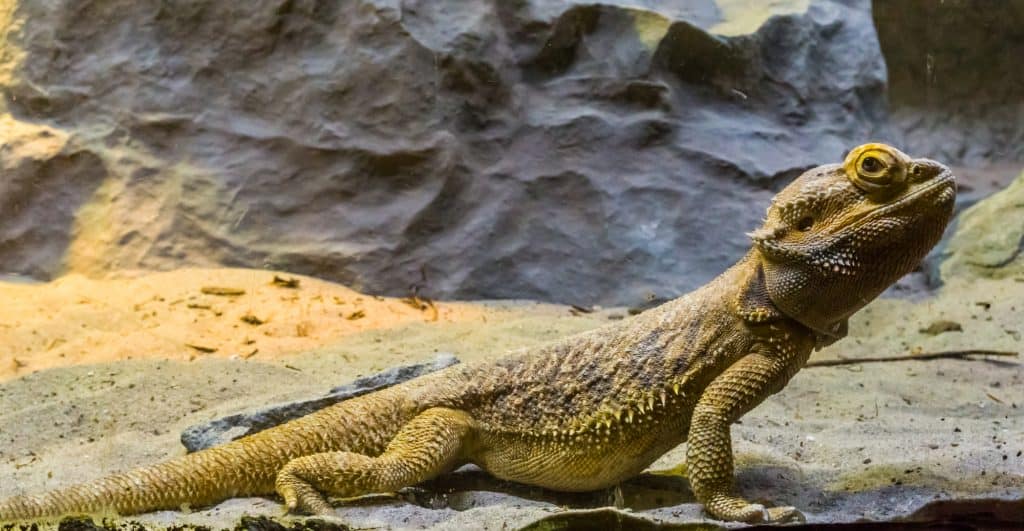
There are tons of different types of fancy disguised dragons. They may have other:
- Colors – brilliant, saturated hues of orangish, cerise, xanthous, white, or blue.
- Patterns – zig-zag, continuous S-shape, horizontal or vertical stripes such every bit a genetic stripe or tiger stripe
- Size – same as normals, with some exceptions*
- Scales – may be irregular, tiny, totally absent-minded, or even see-through
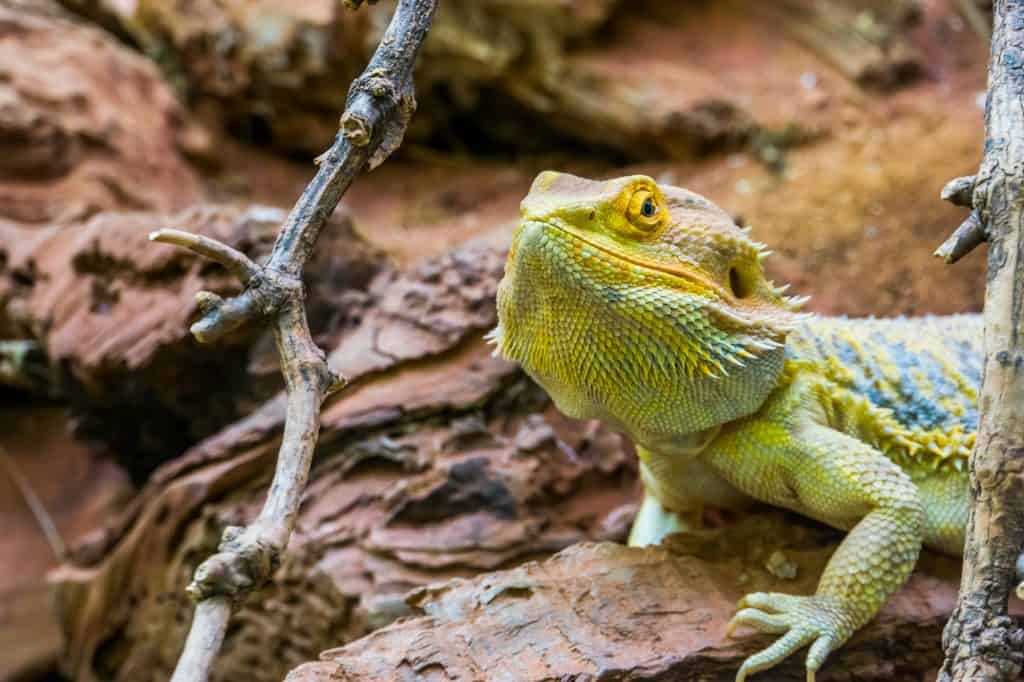
*The German Giant line of fancy bearded dragons has been selectively bred to attain sizes of 25 to xxx inches in length and counterbalance over 680 grams.
*Excessively inbred fancy bearded dragons may exist smaller due to poor health.
Cost
A bearded dragon'southward toll is dependant on several factors, including:
- Age
- Sex
- Source
- Shipping
- Breeding status
- Overall health status
Most dealers commonly sell healthy, infant, normal bearded dragons for $50 to $125.
Fancy disguised dragons may price as piddling as $eighty for common traits, similar orange coloration.
On the other end of the spectrum, disguised dragons with combinations of rare morphs such as genetic stripe and translucent can easily cost over $800.
Health
By and large speaking, fancy bearded dragons are just as good for you as normal bearded dragons. They all have an average lifespan of x to fifteen years.
Breeders with poor practices may mistakenly perpetuate health issues with inbreeding.
The silkback or silkie morph is ane exception to the rule. Their lack of scales leaves them vulnerable to cuts, scrapes, shedding problems, and UVB burns. Just experienced disguised dragon keepers should take on i of these animals.
Husbandry
Most fancy disguised dragons require the aforementioned things as a typical bearded dragon:
- A salubrious diet
- An platonic, suitable habitat
- Proper lighting and heating prepare-ups
- Care and treatment from a qualified veterinarian
Once once more, the exception is silkback fancy bearded dragons. They require some extra efforts, including:
- Skincare
- Assistance shedding
- Extra dietary hydration
- Safe enclosure surfaces
The Best Fancy Bearded Dragon Morphs
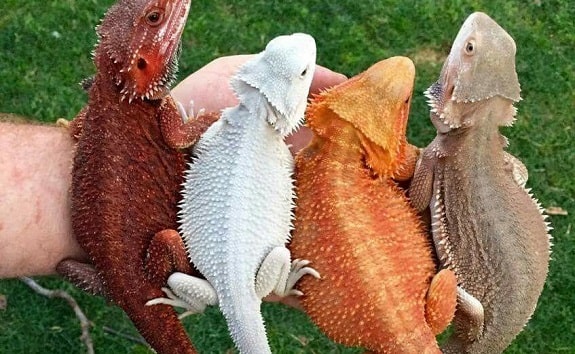
If y'all're looking into adopting a fancy bearded dragon, it tin can exist hard to decide what type to go. We're going to encompass our favorite varieties. Hopefully, they give you some inspiration!
1. Cipher Bearded Dragon
Naught bearded dragons are named after their lack of pattern and colour. These striking lizards are pure white with regular scales.
2. Translucent Bearded Dragon
Translucent or "trans" bearded dragons have encounter-through scales. Babies have a bluish tint to their belly because their organs are more visible. They tend to have night or even black eyes.
3. Witblits Disguised Dragon
Witblits disguised dragons are patternless but still have 1 solid color. They can range from gray to yellow.
4. Dunner Bearded Dragon
The dunner morph affects the scales of bearded dragons. It creates more scales that are scattered and uneven. The spikes besides indicate in random directions.
v. Leatherback Bearded Dragon
Leatherback bearded dragons lack the spiky scales along their back. Their color will appear more vivid. When you breed two leatherback bearded dragons together, y'all tin end up with silkback scaleless bearded dragons.
FAQ
Q: Why Is My Fancy Disguised Dragon Changing Color?
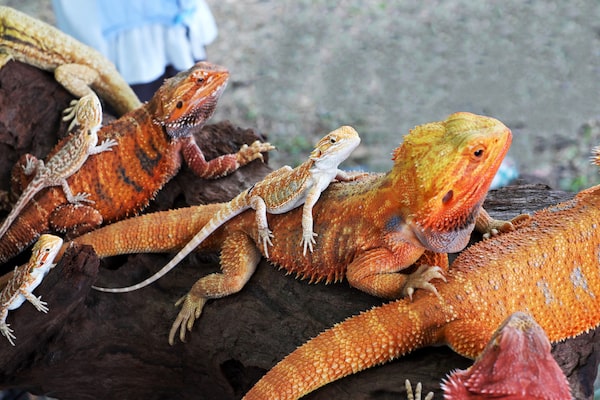
Historic period: Almost fancy disguised dragons go darker with historic period. They'll still always be more colorful than adult normal bearded dragons.
Genetics: Some breeders produce animals that stay brighter as adults. Asking to run across photos of a disguised dragon's parents can aid you determine if the animal has strong genes for color.
Shedding: All reptiles become darker and drabber as they enter their shed cycle. Subsequently they release their old skin, they may be even brighter than before!
Mood: Angry or stressed bearded dragons volition darken in color and may fifty-fifty plow black!
Health: Sick bearded dragons will also become duller and darker in color, and they tin can also turn black.
Q: What Do Fancy Bearded Dragons Eat?
Fancy bearded dragons do good from having the aforementioned diet as normal bearded dragons. A healthy disguised dragon diet includes:
- Fresh water
- Loftier-quality calcium pulverization
- High-quality reptile multivitamin powder
- x%-20% dusted and gut-loaded insects
- lxxx%-ninety% fresh vegetables, including primarily dark leafy greens
Colorful vegetables and foods that are high in vitamin A may raise fancy bearded dragons' coloration.
Q: Are Fancy Bearded Dragons Friendly?
Offset and foremost, information technology's important to remember that whatsoever brute with teeth can bite – including fancy disguised dragons.
However, fancy disguised dragons tend to be just as friendly and personable equally their standard counterparts.
They're likely to be more than friendly than normal bearded dragons who are simply one or two generations removed from the wild.
Diving Deeper Into the Realm of Disguised Dragons
Now that you know what a fancy bearded dragon is, you lot can head over to learn even more most these 22 disguised dragon morphs and types.
If you've already decided what type of fancy bearded dragon y'all'll be bringing abode, don't forget to have some time to option out the perfect proper name!
Source: https://reptile.guide/fancy-bearded-dragons/
Posted by: lewtercand1993.blogspot.com

0 Response to "What Type Of Animal Is The Bearded Dragon"
Post a Comment